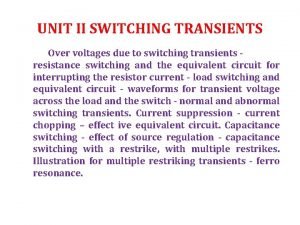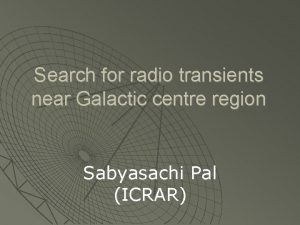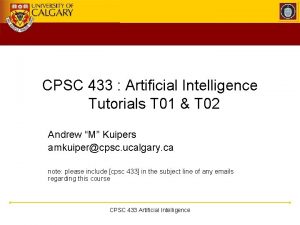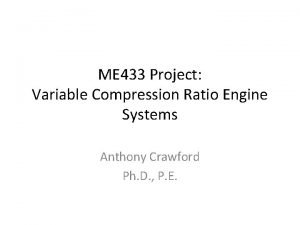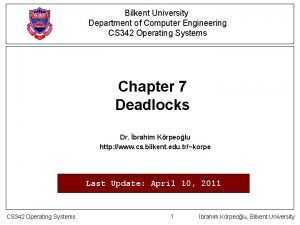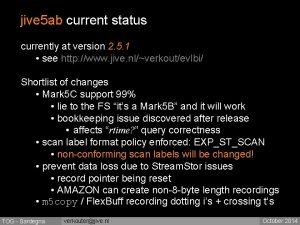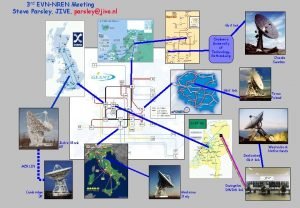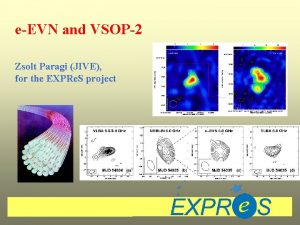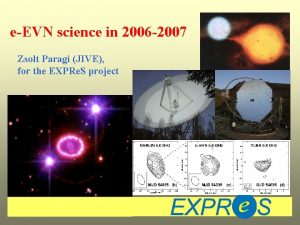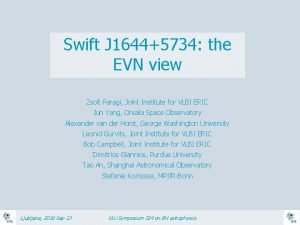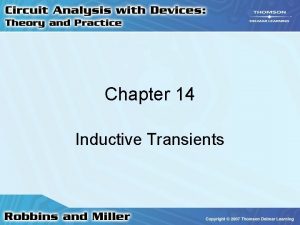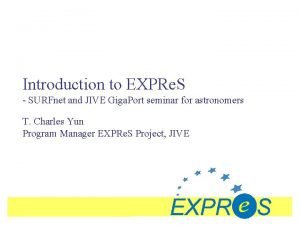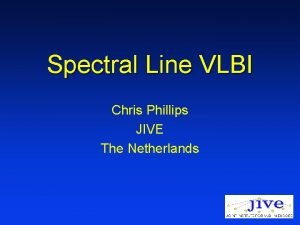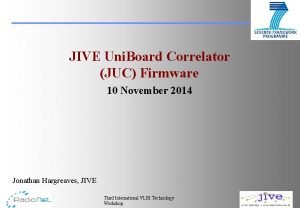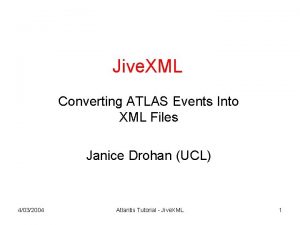SS 433 and other transients Zsolt Paragi JIVE





















![dcore S 12/13 Flux density [m. Jy] X-ray lightcurve Size change [mas] Core size dcore S 12/13 Flux density [m. Jy] X-ray lightcurve Size change [mas] Core size](https://slidetodoc.com/presentation_image/1ea54cbc91246bee156078662fc5ad6a/image-22.jpg)








- Slides: 30

SS 433 and other transients Zsolt Paragi (JIVE) Presented at the Resolving The Sky conference, Manchester, 18 -20 April 2012

Outline • SS 433, an introduction • The radio jets on mas scales: compact jets and discrete ejecta • SS 433 and microquasars • Microquasars/SS 433 and AGN • Other microquasars, transients and Te. V sources with the ‘e-EVN’

SS 433: the first Galactic radio-jet system • Strong, H spectral lines (Stephenson, Sandaluek 1977) • Eclipsing binary, V 1343 Aql, mv=14 mg (Kholopov et al. 1981) • Related radio and X-ray sources • Spectral lines at unusual frequencies (Margon et al. 1979) • Doppler-shifted Balmer and He. I lines (Fabian, Rees 1979, Milgrom 1979) • “moving lines”, between -30000 and +50000 km/s, P~164 days (Margon 1979 b) RADIO • MERLIN: elongated structure on 1” scales (Spencer 1979) • ‘EVN’: compact VLBI structure, ~10 mas (Schilizzi et al. 1979) • VLA: precessing beams (Hjellming, Johnston 1981) A dozen of Nature papers in 1979 More than 2000 papers to date Hope to understand AGN

The binary stellar system: • O, B, or WR normal star, about 10 M or larger • Black hole or neutron star, Mcompact/M ~0, 25 (estimate) • 4 1012 cm (0, 27 AU) (Brinkmann, Kawai, Matsuok 1989) • 13. 081 day orbital period (Kemp et al. 1986) • d. M/dt = 10 -5 10 -4 M /yr (van den Heuvel 1981) • Lbol = 1039 1040 erg/s (e. g. Wagner 1986) • LX = 1036 erg/s (Kotani et al. 1996) • Lkin = 2 1039 erg/s (e. g. Watson et al. 1986) Hjellming, Johnston (1986)

Kinematic model parameters • inclination: i = 78, 83 0, 10 (Margon & Anderson 1989) • precession cone half opening angle: = 19, 85 0, 17 (Margon & Anderson 1989) • precession cone axis projected PA: = 100 2 (Hjellming & Johnston 1981): • sense of precession: s = 1 (Hjellming & Johnston 1981) • jet velocity: vjet = 0, 2602 0, 0013 c (Margon & Anderson 1989) • precession period P 164 = 162, 5 0, 03 day (Margon & Anderson 1989) • precession phase = 0. 0 at: t 164 = JD 2443588, 03 0, 3 (Vermeulen 1989) Hjellming, Johnston (1985)

Kinematic distance and Doppler beaming • Wb, Ef, Jb only! Mk. II/Mk. III • If v=0. 26, d=5. 0 0. 3 kpc ! • cf. HI d=3. 6 kpc Fejes (1986 a) • Unbeamed and beamed models; comparison with real data suggests beaming Is observed as expected Fejes (1986 b) István Fejes (1939 -2011)

EVN 10 -days monitoring at 5 GHz, 1987 D = 5 kpc 0, 001” = 5 AU • elongated radio core • discrete ejecta (bright flares ~400 days) • brightening zone Facts sheet (data: Ralph Spencer; RCV thesis) 1985 May, Mk. III mode E, 14 MHz LCP, EVN: Ef, Jb, On, Mc, Wb 14 1987 May/June, mode A, 56 MHz EVN+GBT 43 m; MERLIN Vermeulen et al. (1993) 1 -pass only 13 minutes Used whole EVN supply of tapes,

The compact inner jets • Optically thin ejecta • Flux ratio (core) @18 cm as expected (beaming) • Optically (partially) thick core jets: • Synchrotron self-absorption, similar to AGN cores (Blandford & Königl 1979) • In addition, anisotropic free-free absorption (cf. Stirling et al. 1997) • Optical depth (Lobanov et al. 1998): • Jet profile (cf. Hjellming and Johnston 1988) ne 1. 2× 106 cm-3 Paragi et al. 1999 VLBA

The equatorial outflow VLBA 22 GHz, 16 June 1998 * Global VLBI, 6 June 1998 Tb~108 K Various epochs/frequencies show evidence for: • free-free absorption at the base of the counterjet • ionized outflow, roughly perpendicular to the jets • radio emission from equatorial outflow detected • synchrotron/thermal origins proposed (cf. Blundell et al. 2001) • but note high Tb!

SS 433 radio polarization • Linear polarization is observed on ~100 mas – as scales (VLA, MERLIN), outside the inner depolarized zone (ionized gas in eq. outflow or in the jet) • B aligned with local velocity => continuous jet (Stirling et al. 2004) • B aligned with ballistic velocity => discrete ejecta (Miller-Jones et al. 2008) • Linear polarization not detected with VLBI yet (but Tudose et al. in prep. ) • Circular polarization is occasionally detected (ATCA; Fender et al. 2000) • Dedicated global VLBI experiment to look for CP origin: non-detection, but also WSRT data show no CP at that epoch (Paragi et al. 2004)

SS 433 with CHANDRA • Reheating of atomic nuclei in the extended X-ray jets • Evidence for very high Lorentz-factor inner flow? – as Fomalont et al. (2001) suggested for Sco X-1? ? ? • Extended emission in eq. flow as evidence for hot gas cannot be 100% confirmed, but may be real (Rob Fender, priv. comm. ) Migliari et al. (2002)

Galactic analogy of an alternative “AGN feedback” process? • Does SS 433 heat up ISM to 107 -8 K? • Mass loss in equatorial wind may reach or even exceed the transfer rate to the jets (King et al. 1999, Paragi 2000) • Ultrafast outflows observed in X-rays in 40% of a sample of 42 galaxies • Regulating BH grow as well as stripping gas from star-forming regions; would naturally explain MBH-Mbulge relation (Tombesi et al. 2012) XMM/NASA

BHXRB state transitions: X-ray HID SIMS High/Soft state discrete ejecta SS 433 as a microquasar • “compact jets” • quenched state • discrete ejecta • known distance, vjet, composition! But • BH or neutron star? • continuously in “soft state” • LX very low while LR high • X-rays from thermal jet Following e. g. Fender et al. (2004) jet suppressed Increasing Accretion rate, increasing Lx~Lr Compact jet line (? ) Low/Hard state

Flaring SS 433 • SS 433 likely has similar accretion state changes to other BHXRBs, but it is hidden from us in the X-rays • vjet is well known in SS 433 from optical lines, but also from VLBI-only measurements of transient ejecta (Vermeulen 1989) • but there may be a very high gamma inner flow (cf. “dark jet”, Miller-Jones et al. 2008) • tempting to interpret more and more assymetric core-jets at higher frequencies with increasing deeper in the jet But • low/high frequencies show discrete ejecta travel at the exact same speed, v=0. 26 c • this also seem to contradict the idea that during outburst in BHXRB there is an increase of , leading to the shocks Following up flaring microquasars with the “e-EVN” has became routine procedure with triggered e-VLBI observations. Tudose et al. (2010)

The Fundamental Plane of Black Hole Activity • Scaling between BHXRB in the hard state and AGN • Not all AGN classes fit • SS 433 is far brighter in radio than hard state BHXRB • Some LLAGN samples have very similar outliers (e. g. de Gasperin et al. 2011) • Why SS 433 is so special? ? ? Merloni et al. (2003); Falcke et al. (2003) Körding et al. (2006) etc.

SS 433 -W 50: a ULX plus radio nebula? 0. 5 deg. . Dubner et al. (1998) • SS 433 accretion disk X-ray emission is scattered along the jets • When viewed along the jets, SS 433 May be seen as a powerful ULX (Fabrika 2000) Supercritical accretion disc funnel: 1. 4 GHz VLA SS 433 Feng & Soria (2011) • A new example of BH powered ULX nebula is IC 342 X-1 (Cseh et al. 2012)

JIVE moments Richard with Queen's Commissioner in the Province of Drenthe, Relus ter Beek, official opening of the EVN correlator (1998) Farewell party @JIVE, 2002 December 17 EU Commissioner Janez Potocnik unleashes the power of e-VLBI, 2006

How we imagined e-EVN follow-up of high energy transients

A few examples…

Strongly decelerating jet in XTE J 1752 -223 • X-ray transient discovered by RXTE on 23 Oct. 2009; gradually evolved to soft state and produced radio flare • Initial EVN/e-VLBI observations on 11 Feb. 2010 one component (A) • VLBA follow-up showed proper motion with strong deceleration and a new component (B) that was initially thought to be the counter-jet. • EVN observations in March showed another ejected component (C) • After the source went back to the hard state two epochs VLBA observations detected the core in the system • Core apparently had high variability • After understanding source geometry, further analysed component B which showed high proper motion during the single experiment it was detected Yang et al. (2010, 2011) Radio core

MAXI J 1659 -152, the shortest orbital period BHXRB Peak position
![dcore S 1213 Flux density m Jy Xray lightcurve Size change mas Core size dcore S 12/13 Flux density [m. Jy] X-ray lightcurve Size change [mas] Core size](https://slidetodoc.com/presentation_image/1ea54cbc91246bee156078662fc5ad6a/image-22.jpg)
dcore S 12/13 Flux density [m. Jy] X-ray lightcurve Size change [mas] Core size [mas] Compact jet interpretation Source size changes vs. flux density and core shift are in agreement with the compact jet model. dcore~1. 8 rcore Coreshift [mas] Hardness-Intensity Some core quenching is observed, but no bright, discrete ejecta through the state transition. Similar behaviour seen in Cyg X-1. (Rushton et al. 2012) Not powerful enough to produce strong shocks in the flow? Paragi et al. (2011) Paragi et al. (in prep. )

HESS J 0632+057, -ray BH binary candidate • Point like, variable Te. V source discovered by the HESS team (Aharonian et al. 2007; Acciari et al. 2009) • Variable counterparts in the X-rays and in the radio band (Hinton et al. 2009 and Skilton et al. 2009, respectively) • Proposed counterpart is the massive B 0 pe star MWC 148, d~1. 5 kpc; SED similar to LSI +61 303, but order of mag. fainter (Hinton et al. 2009) • Swift/XRT: 321 5 d periodicity (Bongiorno et al. 2011) supports binary nature, but binarity with optical spectroscopy not confirmed yet • X-ray outburst in Feb. 2011 (Falcone et al. 2011) • VERITAS and MAGIC reported increased activity at >200 Ge. V between 7 -9 Feb. 2011. (Ong 2011; Mariotti 2011) • e-EVN: first VLBI detection! Moldon, Ribo & Paredes (2011), ATel #3180

e-EVN: -ray BH binary scenario confirmed • Radio emission within 20 AU of MWC 148: confirming optical counterpart and indicating a compact object in close orbit • Tb>106 K – nonthermal radio emission • Follow-up observations during the normal EVN session, 30 days later: extended structure seen ~20 AU off the first epoch position, size ~75 AU Peak: 340 50 Jy/bm Total: 410 90 Jy Peak: 81 14 Jy/bm Total: 200 40 Jy Moldon, Ribo & Paredes (2011), A&A 533, L 7

A surprise from the Crab-nebula VLA (NRAO) HST (NASA/ESA) Radio Optical Chandra (NASA) X-rays

A gamma-ray flare detected by AGILE • A pulsar wind nebula: highly magnetized plasma of relativistic particles collide with ISM AGILE lightcurve, 2010 • Until now has thought to be very stable (at large) in the X-rays and -rays (standard candle) • Early AGILE data showed a flare – calibration or instrumental errors? HST Chandra • September 2010 another flare (~4 days), later confirmed by Fermi • Short duration small size, L ≤ 1016 cm • Wisps, knots and the anvil feature known HST to vary (days to months); interesting features, A in particular, marked to the right (HST/Chandra follow-up) • Pulsar itself did not change – where is the flaring region and what is the mechanism? Tavani et al. 2011, Science Chandra

The Crab-flare with the e-EVN Normal CLEAN, uv-tapered, restoring beam 150 mas Multi-resolution CLEAN, uv-tapered, 500 mas • e-EVN + 3 Merlin telescopes, 1. 6 GHz observations on 5 Nov. 2010 • Detected pulsar, C 1 and C 2 components plus extended emission • Bright optical knot HST-1 not detected • C 1 0. 5 0. 3 m. Jy, ~0. 2– 0. 6”; C 2 0. 4 0. 2 m. Jy, ≤ 0. 2” • SNR<4 for both, but simulations show that they are real Lobanov et al. 2011, Astron. Astrophys 533, A 10

The Crab-flare with the e-EVN HST e-EVN Chandra • e-EVN multi-scale image in contours, restored with 0. 7” beam • C 1, C 2 significant offset from jet axis (jet collimation beyond C 1? ? ? ) • C 1 close to (but not coincident with) knot A – related to –flare? • In this case the injection power generated the burst would be 0. 2% of the pulsar spin-down power Lobanov et al. 2011, Astron. Astrophys. 533, A 10

To be continued. . .

Prof Richard Schilizzi
 Switching transients are *
Switching transients are * Galactic center radio transients
Galactic center radio transients Tutti i poligoni regolari
Tutti i poligoni regolari Hdl-mhrcu.433
Hdl-mhrcu.433 Cpsc 433
Cpsc 433 Numeri fissi apotema
Numeri fissi apotema I9 training
I9 training Pliva 433 street value
Pliva 433 street value Liedboek 441
Liedboek 441 Chem 433
Chem 433 Me 433
Me 433 Sans mgt 433
Sans mgt 433 Cs 433 bilkent
Cs 433 bilkent Jive view test
Jive view test Jive system status
Jive system status Jive partner portal
Jive partner portal Jive parsely
Jive parsely Jive call reports
Jive call reports Conference bridge jive
Conference bridge jive Blockbusters hand jive
Blockbusters hand jive Bartha zsolt
Bartha zsolt Gilányi zsolt piacgazdaság
Gilányi zsolt piacgazdaság Kosztyán zsolt
Kosztyán zsolt Dr völgyi zoltán pápa
Dr völgyi zoltán pápa Web server kft
Web server kft Dr petke zsolt
Dr petke zsolt Dr beke zsolt
Dr beke zsolt Heller zsolt
Heller zsolt Dr törcsvári zsolt
Dr törcsvári zsolt Johanyák zsolt csaba
Johanyák zsolt csaba Mintzberg vezetői szerepek
Mintzberg vezetői szerepek
